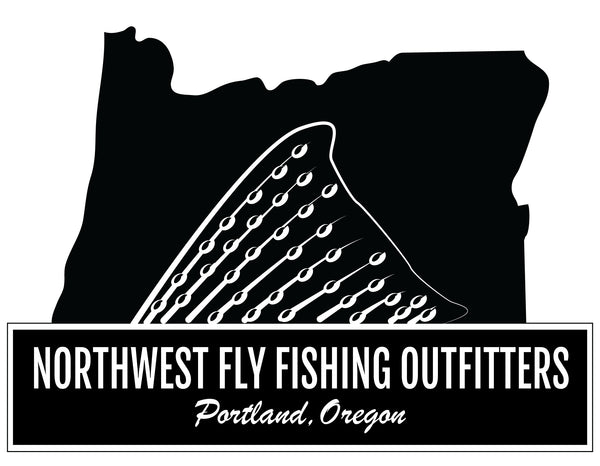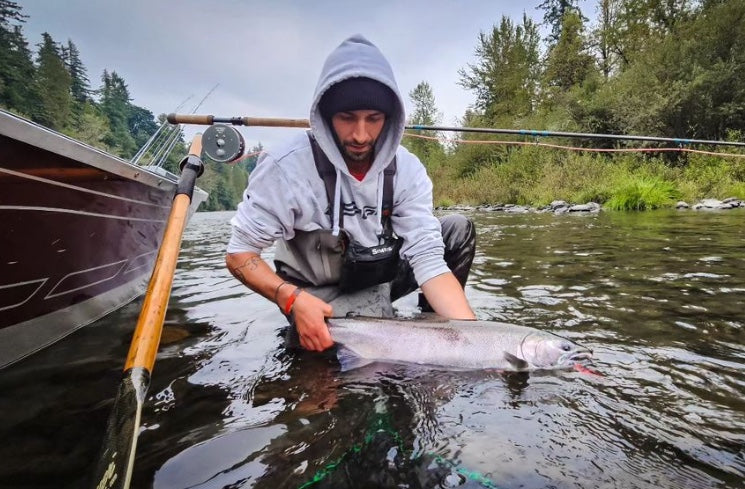We frequently hear questions in our shop regarding the proper stepdown method for swinging flies for steelhead. In this blog post, guide and shop staff member Spencer Pelham answers the question, what is the right way to approach a run, and what is the best step-down method?
There are many different opinions on how many steps we should take downriver when fishing a run. If you ask a group of anglers what their take is on the matter, there’s a good chance you’ll get a few different answers. Some people base it off water clarity or water temps, others swear by 2-3 steps for winter fish, and I’m sure there are a few more opinions on the “best” method for stepping down a run. I’m not the most experienced angler, nor will I claim to know everything about how to swing a run, but I do have some bits of advice that I apply to the fishing tactics that have helped me connect with a few fish on a swung fly in my short time with a Skagit setup.

My first piece of advice is to choose a river and fish it religiously. If you’re fishing the banks, you can scout your Google Maps and spend time trying to find places you can access by roadside or by hike-in. After a while, you will build a list of places you can fish throughout your day or week and not be limited to one piece of water whenever you want to get out. It will also provide you with more options for the day when you show up to your run of choice, and it’s already taken. The more water you can have to fish, the more chances you have of finding a fish.
Next up is reading water. We hear it a lot, but there’s more to reading water than just looking at what speed it is moving at. By watching what the water is doing, you can tell what type of substrate the bottom will likely be. The boils and breaks in the water can translate to what structure is there and where a fish may hold. The color of the water can tell you where the deep buckets are versus the shallow gravel/sand bars. There are a lot of variables to reading water that will help you learn the system you are fishing in greater depth, which will, in turn, help build your confidence on the water.
At this point, you’re probably thinking, “Cool, but what does this have to do with stepping down the run?” Well, let’s talk about it. When I’m fishing new water, or I’m trying to learn a specific run more thoroughly, I will first read the water before fishing it. If I see anything that looks enticing or worth my time, I’ll slow down my steps and work the water with different sink tips and unweighted to weighted flies a few times over. I do this to find extra information by searching the water and its structure with a fly to get feedback on what’s out there. There’s often a rock or depression in the river bottom that I can’t already understand by what the water shows me. If the water is featureless and doesn’t have any structure, I will still swing the water if it is at a decent flow and height, but I will spend less time switching presentations up and move a little quicker down the run or just focus my time on what looks like the “sweet spot” to me.
To summarize, I fish how I feel is most productive for the water before me. If the water I’m swinging a fly in has more than a few features that make a steelhead happy and cozy, I will step slowly through the run and even rework the water with a new presentation. I want to thoroughly fish the water and make sure I didn’t leave any offerings on the table for the fish I believe is there. If the run is wide open, bare, and featureless, I’ll start at the head and extend my cast until I’m fishing a comfortable distance and begin to work downriver. I don’t fish this water as heavily because, to me, it’s the water that the fish will be moving upriver in and are less likely to take a fly. I still swing it for the chance of getting my fly in front of a moving fish, but I spend more time fishing water I think holds fish that are content where they are and are ready to crush anything that comes too close.
Stop by the shop or give us a call if you wanna talk steelhead! It's the season for it and we all love to talk fishing!
Gear That Makes It Easy
Sage Spey 6/7/8
12# M.U.G
10' T-8, T-11, T-14 sink tips
SA Skagit 510/RIO Skagit Max Power 525
35# shooting line
Flies To Consider: Marabou Tubes, Hobo Speys, Intruders, Egg Sucking Leeches
Spencer Pelham
NWFFO Fly Fishing Guide



